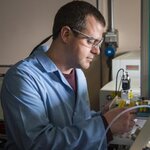Microbiology

There's a hidden battle happening planet-wide at the microbe level.
Researchers have discovered that Arabidopsis thaliana, a small flowering plant widely used as a model organism in plant biology, puts out a welcome mat to bacteria seeking to invade, and a new study reveals new targets during the battle between microbe and host that researchers can exploit to protect plants.
Basically, if the winter annual is putting out a welcome met, scientists have discovered that mat's molecular mix.
The study reveals new targets during the battle between microbe and host that researchers can…

For the first time, researchers have studied the Black Death bacterium's entire family tree to fully understand how some of the family members evolve to become harmful. Contrary to popular belief, pathogenic members of this bacterial family do not share a recent common disease-causing ancestor, but instead, have followed parallel evolutionary paths to become harmful.
The Yersinia family of bacteria has many sub species, some of which are harmful and others not. Two of the most feared members of this bacterial family are Yersinia pestis, the bacterium responsible for the bubonic plague or the…

The ability to program living holds tremendous potential for energy, agriculture, water remediation and medicine, and synthetic biology is on the case.
Researchers have already designed a 'tool box' of small genetic components that act as intracellular switches, logic gates, counters and oscillators but wiring those components together to form larger circuits that can function as 'genetic programs' has been difficult, because of the small number of available wires.
Okay, no more metaphors, you get the idea. A new paper describes development of a rapid and tunable post-translational…

The bacterium Bacillus subtilis is quite adaptable, it moves about in liquids and on agar surfaces by means of flagella and alternatively, it can just stick to an underlying substrate.
The bacteria proliferate most effectively in this stationary state, while motile bacteria reproduce at a noticably lower rate.
In order to sustain and extend the colony, bacteria primarily require sufficient nutrients. Moving slowly means that nutrients are soon used up, but adventurous bacteria that decide to move out fast in search for a microbial Cockaigne may end up feeling lonely.
Which strategy…

Food-poisoning outbreaks linked to Escherichia coli are often associated with tainted meat products but up to 30% of these are caused by people eating contaminated vegetables, and that has risen with the popularity of the organic process, as was seen in the 2011 outbreak in Europe that caused 53 deaths.
A new presentation at the Society for General Microbiology's Annual Meeting in Liverpool showed that disease-causing E. coli O157:H7 interacts directly with plant cells, allowing it to anchor to the surface of a plant, where it can multiply.
The researchers said that E. coli O157:H7 uses…

Humans depend on microbes for survival. So do most animals and such symbioses can persist for millions of years.
Scientists have discovered that certain wasps tightly control mother-to-offspring transmission of their bacterial symbionts. This stabilizes the symbiotic alliance and contributed to its persistence over the past 68-110 million years.
Symbiotic associations are ubiquitous in nature and play a pivotal role for the ecology and evolution of most organisms on earth. This is exemplified by mykorrhizal fungi that are important nutritional partners for up to 90% of all land plants. Many…

It's no secret that bacterial parasites can change creatures. The parasitic lancet liver fluke infects the brain of ants, compelling them to climb to the tip of a blade of grass and into the mouth of a grazing animal. Another parasite is thought to change the behavior of rats to make them more susceptible to predation.
They basically become zombies. And some bacterial parasites can even turn plants into the living dead.
A parasitic bacterium produces a protein called SAP54 that is essential to this process. The protein is dependent for its activity on a family of plant proteins…

Not many people care about where the yeast that makes much of modern beer possible came from. But science cares.
The cold-adapted yeast that blended with a distant cousin to make the lager-churning hybrid has been a biological black box for the last 500 years of industrial fermentation, even though fermentation underpins the production of everything from soy sauce to biofuel. A few years ago, scientists identified the South American yeast that, hundreds of years ago, somehow hitched a ride to Bavaria and combined with the domesticated Old World yeast used for millennia to make ale and…

Of the uncertainties facing climate modelers, climate feedbacks from decomposition by soil microbes are among the biggest.
The dynamics among soil microbes allow them to work more efficiently and flexibly as they break down organic matter – spewing less carbon dioxide into the atmosphere than previously thought, according to a new study from the International Institute for Applied Systems Analysis (IIASA) and the University of Vienna published in Ecology Letters.
"Previous climate models had simply looked at soil microbes as a black box," says Christina Kaiser, lead author of the…

The antibiotic-resistant bacterium Klebsiella pneumoniae sequence type 258 (ST258) is the predominant cause of human infections among bacteria classified as carbapenem-resistant Enterobacteriaceae (CRE), which kill approximately 600 people annually in the United States and sicken thousands more.
Most CRE infections occur in hospitals and long-term care facilities among patients who are already weakened by unrelated disease or have undergone certain medical procedures.
Using genome sequencing, researchers have have tracked the evolution of ST258 K. pneumoniae strains and found…